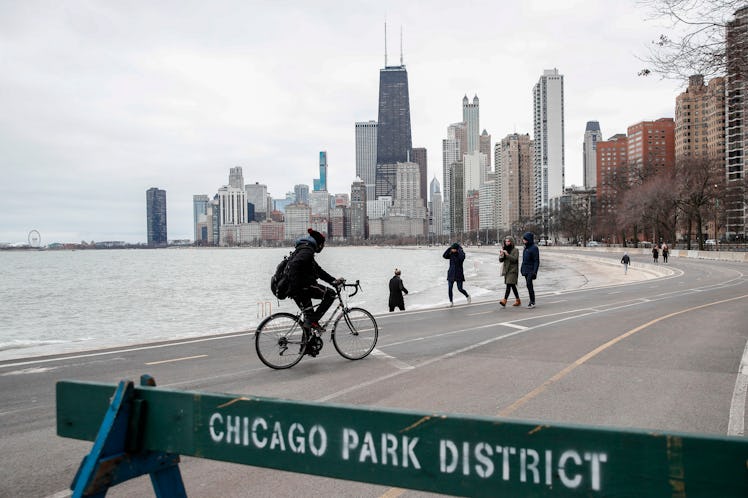
Here's What To Remember About Going Outdoors During The Coronavirus Pandemic
More than two weeks after the World Health Organization (WHO) declared the coronavirus a pandemic on March 11, the disease continues to spread, with more than 93,000 confirmed cases in the United States as of March 27. As various cities and states implement increasing restrictions on residents' movement, you might be wondering — can you get coronavirus outdoors? If you don't practice social distancing, it is a possibility.
Around the country, many residents have been told to shelter in place and stay indoors except for necessary movement, like getting groceries, walking dogs, or heading to work if you're an essential worker like health care professionals or grocery store clerks. But the requirements to stay indoors have left some people confused about whether it's a risk just to go outside. According to Dr. Adolfo García-Sastre, a microbiology professor and director of the Global Health and Emerging Pathogens Institute at Mount Sinai's Icahn School of Medicine, it is not the actual act of going outside that puts you at risk, but rather the proximity you might have to other people. "Going outdoors just increases your possible infection rate if you get closer to someone outdoors, if you touch a contaminated surface and your face afterwards," García-Sastre tells Elite Daily via email. "One needs to be more careful outdoors because you cannot control things the same as [you can] in your home."
"The virus does not remain around in the open air very long," García-Sastre adds, "so in general, going outdoors is unlikely to get you infected." According to the CDC, the coronavirus is most commonly spread between people who are within six feet of each other, through respiratory droplets produced by someone who has been infected.
According to The New York Times, the coronavirus can survive for up to 24 hours on cardboard, and up to 72 hours on plastic and steel. As a result, if you're careful about what you touch when you're outside and you make sure not to run or walk too closely — that is, within six feet — to other people, you're not necessarily at high risk of contracting the virus. The biggest risk, according to Al Jazeera, exists on public transportation and airplanes, where respiratory droplets containing the virus can be spread through seats, armrests, and poles.
"If you’re on a subway and there’s no one on it but the pole was recently touched by someone who was infected, you could conceivably get it from that," Vincent Racaniello, Ph.D, a microbiology and immunology professor at Columbia University's Irving Medical Center, tells Elite Daily. However, Racaniello adds, going outside isn't inherently risky if there's nobody around you.
"People are the source of the virus, so if you’re going for a walk and there’s no one around you, you’re not going to get infected because you need another person to either touch you or give it to you," Racaniello says. As long as you maintain your distance from others and avoid large congregations of people, Racaniello adds, you should be able to avoid exposure to the virus.
Not everybody has been observing social distancing practices, however, prompting cities like Chicago to close popular public spaces to avoid overcrowding. That doesn't mean, however, you should never go outside — and in fact, staying inside all the time could be detrimental to your mental health, says Karen Levy, Ph.D, an epidemiologist and associate professor of environmental health at Emory University's Rollins School of Public Health.
"It is a great idea to go outdoors, so long as you can maintain social distancing (6 feet of distance between yourself and others) while outside," Levy tells Elite Daily via email. "While the virus can survive in the air for short periods of time, that is not what is driving transmission. Transmission of the virus primarily occurs through person-to-person contact."
Levy recommends people do continue to go outside and engage in some physical activity, as long as they continue practicing social distancing. For now, if you have not been exposed to the coronavirus and you're not showing symptoms, it is still safe for you to go outside — but only if you practice basic hygiene, avoid nonessential contact with others, and limit your outings. You can still go out for a walk or to get groceries, but don't congregate with groups of people or go within six feet of passersby. The CDC recommends that everyone wash their hands with soap and water for at least 20 seconds, stay home when sick, and regularly clean high-touch surfaces.
If you think you’re showing symptoms of coronavirus, which include fever, shortness of breath, and cough, call your doctor before going to get tested. If you’re anxious about the virus’s spread in your community, visit the CDC for up-to-date information and resources, or seek out mental health support. You can find all Elite Daily's coverage of coronavirus here.
Experts cited:
Dr. Adolfo García-Sastre, microbiology professor and director of the Global Health and Emerging Pathogens Institute at Mount Sinai's Icahn School of Medicine
Vincent Racaniello, Ph.D, Higgins Professor of Microbiology and Immunology at the Columbia University Irving Medical Center
Karen Levy, Ph.D, MPH, associate professor of environmental health at Emory University's Rollins School of Public Health
This article was originally published on